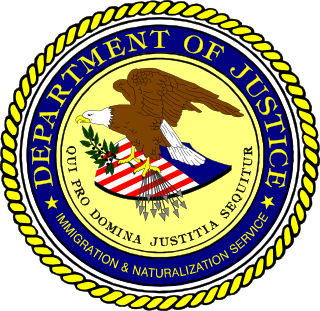
The United States Immigration and Naturalization Service (INS) was an agency of the U.S. Department of Labor from 1933 to 1940 and the U.S. Department of Justice from 1940 to 2003.

The United States Customs Service was a federal law enforcement agency of the U.S. federal government. Established on July 31, 1789, it collected import tariffs, performed other selected border security duties, as well as conducted criminal investigations.

A border guard of a country is a national security agency that performs border security. Some of the national border guard agencies also perform coast guard and rescue service duties.
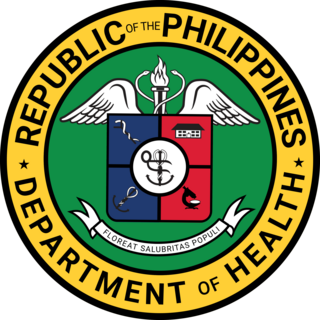
The Department of Health is the executive department of the government of the Philippines responsible for ensuring access to basic public health services by all Filipinos through the provision of quality health care, the regulation of all health services and products. It is the government's over-all technical authority on health. It has its headquarters at the San Lazaro Compound, along Rizal Avenue in Manila.

The Presidential Communications Group, or simply the Communications Group, is the collective name for the offices within the Office of the President of the Philippines and refers to the position of the Secretary of Presidential Communications Office formerly known as Office of the Press Secretary and the Secretary of the Presidential Communications Operations Office (PCOO). The office of the presidential spokesperson was previously under the Communications Group.

The Professional Regulation Commission, otherwise known as the PRC, is a three-man commission attached to Department of Labor and Employment (DOLE). Its mandate is to regulate and supervise the practice of the professionals who constitute the highly skilled manpower of the country. As the agency-in-charge of the professional sector, the PRC plays a strategic role in developing the corps of professionals for industry, commerce, governance, and the economy.

The Philippines' Bureau of Plant Industry, is an agency of the Philippine government under the Department of Agriculture responsible for serving and supporting the Philippine plant industry sector.

The Land Transportation Franchising and Regulatory Board is an agency of the Republic of the Philippines under the Department of Transportation (DOTr). The LTFRB was established on June 19, 1987, during the former president Corazon Aquino’s administration.

The Civil Aviation Authority of the Philippines is the civil aviation authority of the Philippines and is responsible for implementing policies on civil aviation to assure safe, economic and efficient air travel. The agency also investigates aviation accidents via its Aircraft Accident Investigation and Inquiry Board. Formerly the Air Transportation Office, it is an independent regulatory body attached to the Department of Transportation for the purpose of policy coordination.

The Bureau of Internal Revenue(Filipino: Kawanihan ng Rentas Internas, or BIR) is a revenue service for the Philippine government, which is responsible for collecting more than half of the total revenues of the government. It is an agency of the Department of Finance and it is led by a Commissioner.
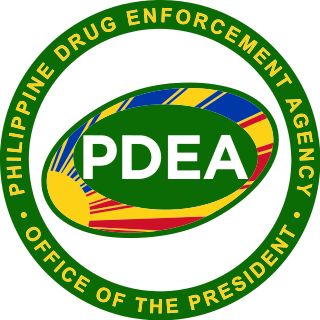
The Philippine Drug Enforcement Agency is the lead anti-drug law enforcement agency, responsible for preventing, investigating and combating any dangerous drugs, controlled precursors and essential chemicals within the Philippines. The agency is tasked with the enforcement of the penal and regulatory provisions of Republic Act No. 9165, otherwise known as the Comprehensive Dangerous Drugs Act of 2002.

The National Commission on Muslim Filipinos is a government agency in the Philippines, whose objective is to promote the rights of Muslim Filipinos and to make them active participants in Philippine nation-building.
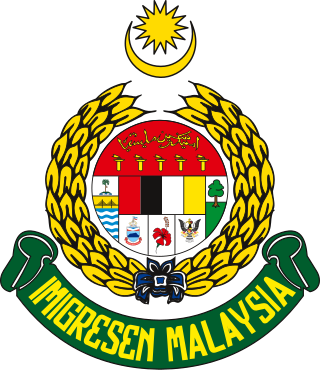
The Immigration Department of Malaysia is a department of the Malaysian federal government that provides services to Malaysian citizens, permanent residents and foreign visitors. The department is responsible for issuing passports, travel documents, visas, passes and permits; administering and managing the movement of people at authorised entry and exit points; and enforcing immigration legislation including the Immigration Act 1959/63 and the Passport Act 1966. The department is a section of the Ministry of Home Affairs.

The Food and Drug Administration (FDA) of the Philippines, formerly the Bureau of Food and Drugs, is a health regulatory agency under the Department of Health created on 1963 by Republic Act No. 3720, amended on 1987 by Executive Order 175 otherwise known as the “Food, Drugs and Devices, and Cosmetics Act”, and subsequently reorganized by Republic Act No. 9711 otherwise known as “The Food and Drug Administration Act of 2009”. The agency is responsible for licensing, monitoring, and regulation of cosmetics, drugs, foods, household hazardous products, medical devices and electromagnetic radiation emitting devices, pesticides, tobacco and related products, and vaccines for safety, efficacy, and quality in the Republic of the Philippines.
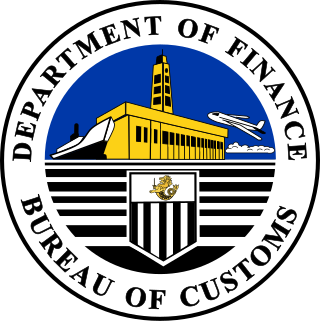
The Bureau of Customs is a Philippine government agency under the Department of Finance. The Bureau of Customs was established on February 6, 1902 by the Insular Government of the Philippine Islands of the United States of America, during the American Colonial Era of the Philippines.
Ronaldo Alea Geron is the Commissioner of the Bureau of Immigration of the Philippines. Geron was appointed on January 6, 2016, by President Benigno S. Aquino III. Prior to being appointed as Commissioner, he was the Deputy Executive Secretary for Finance and Administration of the Office of the President. A lawyer by profession, he is a graduate of the University of the Philippines College of Law. Geron has been in government for over 20 years. Before joining the national government, Geron was provincial administrator and provincial board member of Batangas province.
The National Privacy Commission, or NPC, is an independent body created under Republic Act No. 10173 or the Data Privacy Act of 2012, mandated to administer and implement the provisions of the Act, and to monitor and ensure compliance of the country with international standards set for data protection. It is attached to the Philippines' Department of Information and Communications Technology (DICT) for purposes of policy coordination, but remains independent in the performance of its functions. The Commission safeguards the fundamental human right of every individual to privacy, particularly Information privacy while ensuring the free flow of information for innovation, growth, and national development.

The Bureau of Fire Protection is the government body in the Philippines responsible for the provision of fire services. It is under the jurisdiction of the Department of the Interior and Local Government.
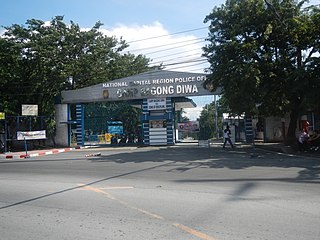
The Bureau of Immigration Bicutan Detention Center (BI–Bicutan) is the principal immigration detention center administered by the Bureau of Immigration of the Philippines. Located inside Camp Bagong Diwa, in Lower Bicutan, Taguig, the facility is known internally as the Warden Facility and Protection Unit (WFPU). However, in press releases and public statements, the Bureau variously refers to the facility as being a "jail", "warden facility" or "detention center". The function of the facility is to hold foreign detainees who are awaiting deportation, for example, because they have pending criminal cases, or because they are accused of having overstayed their visas.




















